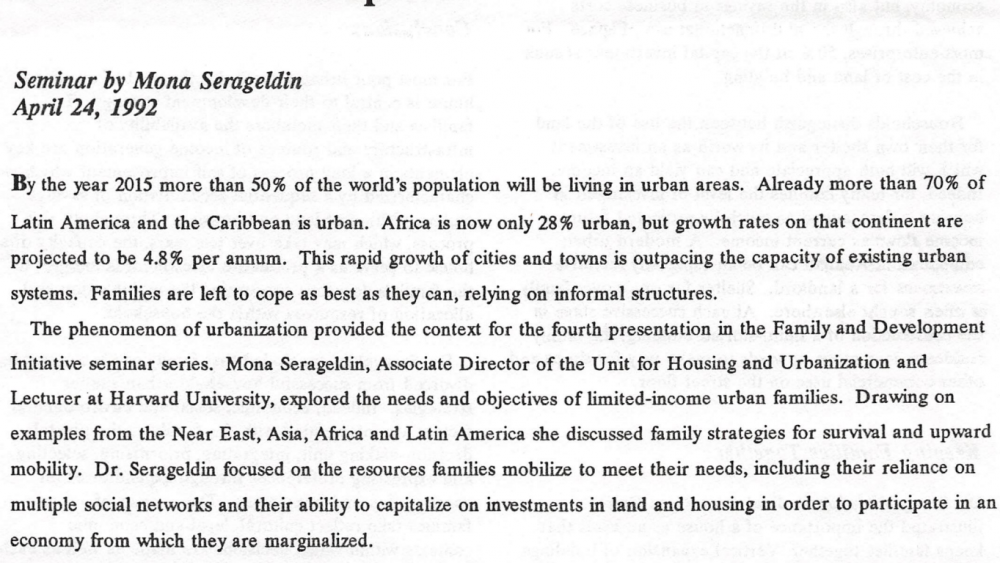Abstract
Mona Serageldin directed a report series titled “Economy of Historic Preservation” in 2014, in collaboration with the Ministry of Municipalities and Tourism (MOMT) and the Iraqi-Kurdistan Erbil Governorate. The project fulfilled a UN-Habitat program “Strengthening Urban and Regional Planning” (SURP), with support from François Vigier and Barbara Summers.
The report examines the interrelationship of cultural heritage preservation and urban development – in light of globalization, urbanization shifts and technological innovation. The analysis aligned with the SURP program goals, which support the capacity of officials in Erbil, a Kurdistan region of Iraq to stimulate financing for local infrastructure, and promote land value capture and community participatory processes.
Documents include the main report in two sections, an outline, slides for the full presentation, and supporting presentations with photographs. Case studies cover cultural heritage sites in the Medina of Tunis, Tunisia; Icheri Sheher in Baku, Azerbaijan, and in Quito, Ecuador.
See also: “National Urban Strategy for Governorates in Iraq,” UN-Habitat (UNDP) and Iraq Ministry of Planning (LADP II), 2014-2018
See related I2UD projects below
| Project Year: | 2014 |
| Project Type: | Capacity Building Project |
| Geographic Regions: | Erbil, Southern Kurdistan, Iraq (also Medina of Tunis, Tunisia; Icherisheher, Baku, Azerbaijan; and Quito, Ecuador) |
| Reports: | Economy of Historic Preservation: Part 1 “Heritage Preservation and Urban Development” (Overview) Economy of Historic Preservation: Part 2 (Case Studies) Economy of Historic Preservation: Full Presentation Economy of Historic Preservation: “Overview of Municipal Finance” (Presentation, March 2015) Economy of Historic Preservation: “What is Culture? Categories of Economic Values Attributed to Cultural Heritage Assets” (Presentation) |
| Authors: | Mona Serageldin; François Vigier; Barbara Summers; David C. Jones |
| Sponsors: | United Nations Centre for Human Settlements (UN-Habitat) |
| Categories: | Historic Districts |
| ID: | 2014_06_002 |
Related I2UD Projects
Related by – Historic District Preservation
Design Studio 1981: “Housing Design in Islamic Cultures” in Algeria, Bangladesh, Egypt, Iraq, Pakistan, Saudi Arabia and Indonesia, Seminar Curriculum
“Economy of Historic Preservation” in Erbil, Kurdistan, Report for Strengthening Urban & Regional Planning (SURP), UN-HABITAT, 2014
“Comprehensive Plan for Makkah, Madinah and Mashaer,” Urban Development Strategy for Ancient Holy Sites in Saudi Arabia, 2009
“Sustainable Development Based on Valorizing the Historic Urban Fabric,” Paper by Dr. Mona Serageldin, 9th World Congress of the Organization of World Heritage Cities in Kazan, Tatarstan, Russia, 2007
“Integrated Area Management Action Plan,” Urban Management Plan for the Ancient Walled City Icheri Sheher, Baku, Azerbaijan, 2006
“Revitalization of Kars Historic Center” & “Strategies for Sustainable Development,” Technical Assistance and Capacity-Building for Kars, Turkey, 2004-2008
“Cooperation and Capacity Building for Promoting Cultural, Natural and Built Heritage in Transylvania,” Technical Assistance Report for Brașov, Sibiu, Sighișoara and Târgu Mureș, Romania, 2004
“Continuity and Change” by Dr. Mona Serageldin, Topic Paper for 48th World Congress, International Federation for Housing and Planning (IFHP), 2004
“Historic Center of Mexico City” Diagnostic Summary, Technical Assistance for Mexico City, Mexico, 2003
“Master Plan for the Revitalization of the Older Urban Fabric,” Preservation in the Old City of Al Qusair, Egypt, 2000
“St. Petersburg Center City Rehabilitation Project,” Urban Planning Network for St. Petersburg, Russia, 2000
“Preserving the Historic Urban Fabric in a Context of Fast Paced Change,” Research Essay by Dr. Mona Serageldin, 1998
“Lublin Local Initiatives Program” & “Lublin Old Town Rehabilitation Project,” Technical Assistance for Urban Upgrading in Lublin, Poland, 1994-2000
“Samarkand, Uzbekistan: Revitalization and Rehabilitation of the Historic District,” Technical Assistance for the City of Samarkand, Uzbekistan, 1994
“Upgrading and Conservation of the Walled City of Lahore,” Regional Report on the Preservation of Historic Lahore, Pakistan, 1988


